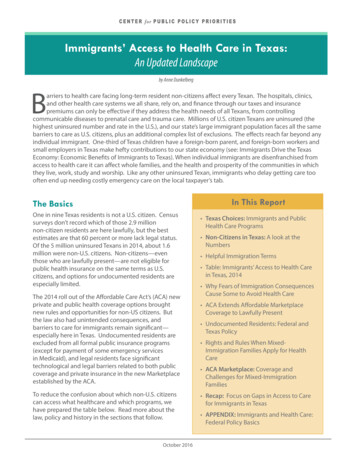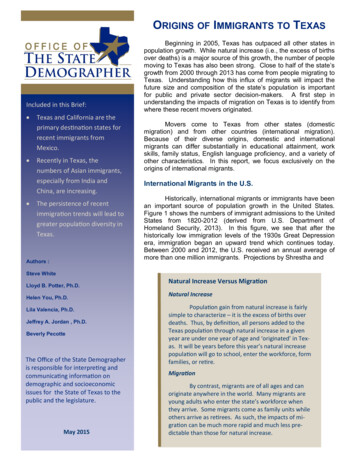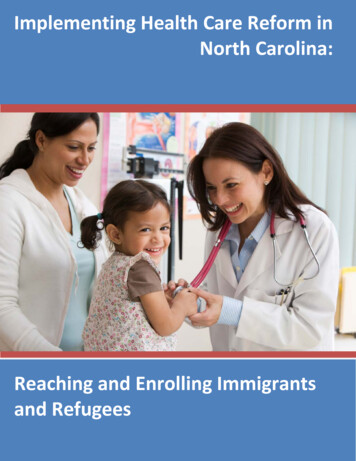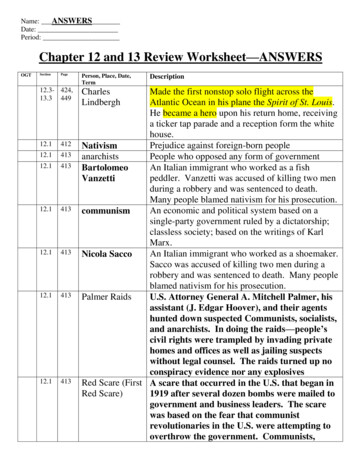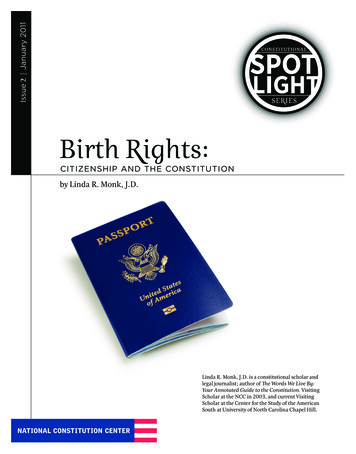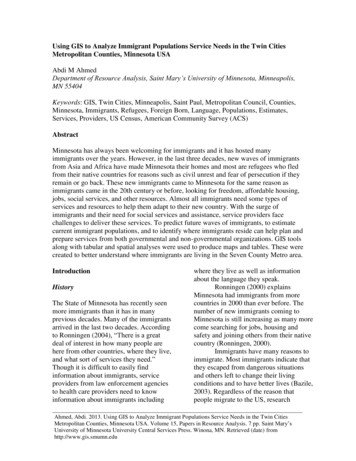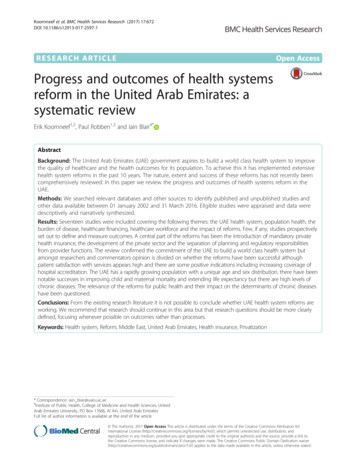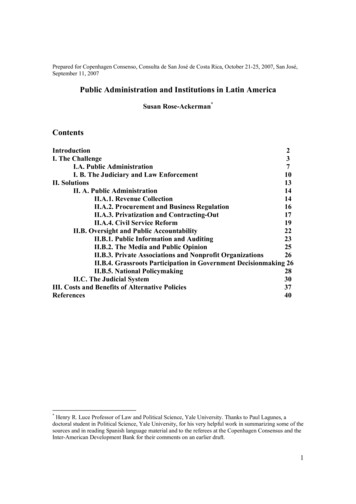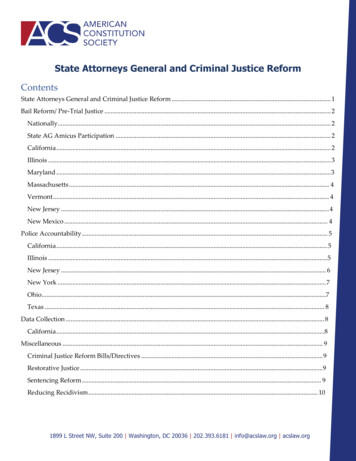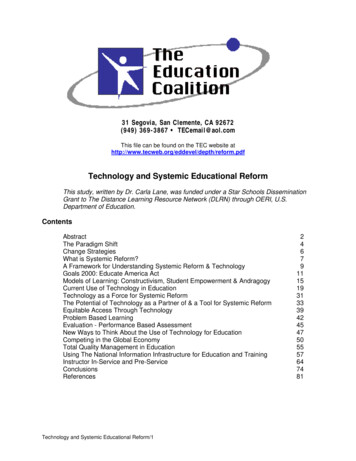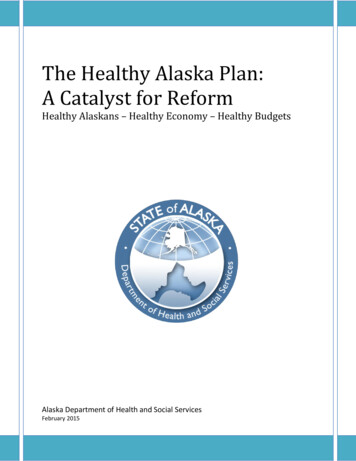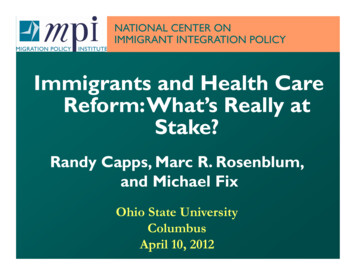
Transcription
NATIONAL CENTER ONIMMIGRANT INTEGRATION POLICYImmigrants and Health CareReform: What’s Really atStake?Randy Capps, Marc R. Rosenblum,and Michael FixOhio State UniversityColumbusApril 10, 2012
Today’s Presentation Trends in total, illegal immigration Snapshot of immigrants’ healthinsurance coverage The scope of health care reform:eligibility rules and mandates Verification of legal status: issues andchallenges The Supreme Court challenge: potentialimpact on immigrants’ coverage
40 Million Immigrants in 2010:Nearly 13% of US Population4040 Million(2010)302014.8%12.9%(1890)(2010)104.7% (1970)0184018601880190019201940196019802000Source: Urban Institute and MPI analysis of the American Community Survey (various years) and Decennial Census (various years) 2011 Migration Policy Institute
Unauthorized 28% of All Immigrants—Naturalized, LPR Shares Slightly HigherUnauthorized immigrants:(11.2 million) 28%2005: 30%Naturalized citizens:(14.9 million) 37%Legal temporaryresidents:(1.7 million) 4%Lawful permanentresidents (LPRs):(12.4 million) 31%2005: 31%40.2 million* foreign born (13%) as of March 2010* Higher than published totals because amount includes undercounted immigrantsSource: Passel, Jeffery S., and D’Vera Cohn. 2011. Unauthorized Immigrant Population: National and State Trends.Washington, DC: Pew Hispanic Center. 2011 Migration Policy Institute
Unauthorized Immigrant Population SizeUncertain, Likely Not GrowingEstimate basedon weightsusing:Source: Hoefer, Michael, Nancy Rytina, and Bryan Baker. 2012. Estimates of the Unauthorized Population Residing in theUnited States: January 2011. Washington, DC: US Department of Homeland Security, Office of Immigration Statistics.
Today’s Presentation Trends in total, illegal immigration Snapshot of immigrants’ healthinsurance coverage The scope of health care reform:eligibility rules and mandates Verification of legal status: issues andchallenges The Supreme Court challenge: potentialimpact on immigrants’ coverage
Employer-Sponsored Coverage ofWorking-Age Adults 18-64, 2007All adults67%64%Low-income adults(income below 150% FPL)46%31%21%US-born citizens19%Naturalized citizens15%Lawful permanentresidents14%UnauthorizedimmigrantsSource: MPI analysis of CPS Annual Social and Economic Supplement, March 2008, augmented by assignments of legalstatus to noncitizens provided by Pew Hispanic Center.
Employer-Sponsored Coverageof Children 0-17, 2007All children61%Low-income children(income below 150% FPL)60%38%31%22%18%11%US-born citizensNaturalized citizensLawful permanentresidents16%UnauthorizedimmigrantsSource: MPI analysis of CPS Annual Social and Economic Supplement, March 2008, augmented by assignments of legalstatus to noncitizens provided by Pew Hispanic Center.
Medicaid Coverage ofWorking-Age Adults 18-64, 2007All adultsLow-income adults(income below 150% FPL)26%7%US-born citizens24%23%10%7%Naturalized citizensLawful permanentresidentsN/A:Ineligiblefor MedicaidUnauthorizedimmigrantsSource: MPI analysis of CPS Annual Social and Economic Supplement, March 2008, augmented by assignments of legalstatus to noncitizens provided by Pew Hispanic Center.
Medicaid/SCHIP Coverage ofChildren 0-17, 2007All childrenLow-income children(income below 150% FPL)58%55%45%33%23%18%US-born citizensNaturalized citizensN/A:Ineligiblefor MedicaidLawful permanentresidentsUnauthorizedimmigrantsSource: MPI analysis of CPS Annual Social and Economic Supplement, March 2008, augmented by assignments of legalstatus to noncitizens provided by Pew Hispanic Center.
Uninsured Working-AgeAdults 18-64, 2007All adults73%Low-income adults(income below 150% FPL)56%59%43%37%16%US-born citizens37%20%Naturalized citizensLawful permanentresidentsUnauthorizedimmigrantsSource: MPI analysis of CPS Annual Social and Economic Supplement, March 2008, augmented by assignments of legalstatus to noncitizens provided by Pew Hispanic Center.
UninsuredChildren 0-17, 2007All children53%Low-income children(income below 150% FPL)44%30%23%16%10%US-born citizens25%14%Naturalized citizensLawful permanentresidentsUnauthorizedimmigrantsSource: MPI analysis of CPS Annual Social and Economic Supplement, March 2008, augmented by assignments of legalstatus to noncitizens provided by Pew Hispanic Center.
Immigrants are 29% of UninsuredWorking-Age Adults and ChildrenUS-born citizens(33.2 million)71%Lawful permanentresidents(4.2 million) 9%Unauthorizedimmigrants(6.8 million) 15%Naturalized citizens(2.3 million) 5%46.6 million total uninsured adults 18-64, plus children 0-17Source: MPI analysis of CPS Annual Social and Economic Supplement, March 2008, augmented by assignmentsof legal status to noncitizens provided by Pew Hispanic Center.
Coverage Varies by State Employer coverage of working-age LPRs:60% in PA, MI, WA;41% in AZ, 40% in CA, and 36% in TX. Unauthorized employer coverage:Over 40% in PA, MI, MA, IL;Under 25% in TX, GA, NC, and 20% in AZ. Uninsurance is reverse: Highest in TX andSoutheast, lowest in MA, NY, other Northeast. Most significant Medicaid coverage of LPRadults in NY, MA (22% each).Children’s coverage — same pattern butlower uninsurance, higher Medicaid/SCHIP
Noncitizens as Share of UninsuredWorking-Age Adults 18-64, 2007Unauthorized immigrants50%Lawful permanent CSource: MPI analysis of CPS Annual Social and Economic Supplement, March 2008, augmented by assignments of legalstatus to noncitizens provided by Pew Hispanic Center.
Today’s Presentation Trends in total, illegal immigration Snapshot of immigrants’ healthinsurance coverage The scope of health care reform:eligibility rules and mandates Verification of legal status: issues andchallenges The Supreme Court challenge: potentialimpact on immigrants’ coverage
Overview of the MainAffordable Care Act Provisions Medicaid coverage extended for adultswith incomes up to 133% of federalpoverty level Subsidies to buy private insurance upto 300% FPL State insurance exchanges Employer penalties Individual mandates
Eligibility for Medicaid andInsurance Subsidies Medicaid: Current law imposes a5-year wait for LPR eligibility Subsidies: No waiting period Options not taken: Eliminate Medicaid waiting period Impose waiting period for subsidies
Eligibility for Medicaid andInsurance Subsidies Number affected (LPRs 5 yrs residency): Medicaid: 600,000 adultsSubsidies: 550,000 adults 90,000 children Costs of including recent LPRs: Medicaid: 6,120 per enrolleeSubsidies: 4,600 - 6,000 per enrollee Cost of excluding recent LPRs: Cost-shifting to states/emergency providersCost-shifting to futureIncreased premiums for US citizens
Unauthorized PopulationCannot Access Exchanges Number affected: 360,000 currently buy their own insurance6.6 million currently uninsured Costs of including unauthorizedimmigrants in exchanges: no direct costs Costs of excluding unauthorized: Screening costsCost-shifting to states/emergency providersCost-shifting to futureIncreased premiums for US citizens
Employer Penalties: Limited Reach Fines for employers not providing insurance Fines only imposed on firms with 50 workers. 38% of LPRs work for firms with 25 employees(versus 28% of US born). Only 32% of LPRs in these small firms haveemployer coverage (versus 71% of US born). 46% of unauthorized work for these small firms. 22% of unauthorized in small firms are covered.Many immigrant workers will be uncovered
Scope of Penalties/Mandates Employer penalties may favor hiringunauthorized workers, because they areNOT in exchanges and therefore do NOTsubject employers to fines. Unauthorized are exempt frommandates, but legal immigrants aresubject to them. Insurance may become moreunaffordable for lower-incomeimmigrants.
Today’s Presentation Trends in total, illegal immigration Snapshot of immigrants’ healthinsurance coverage The scope of health care reform:eligibility rules and mandates Verification of legal status: issues andchallenges The Supreme Court challenge: potentialimpact on immigrants’ coverage
Verification Issues Verification challenges Identity authenticationEligibility verification Scope of the problem Loss of coverage/delays for eligible workersFraudulent access by the unauthorized Tools available DocumentsSAVE systemTax system
Verification Policy Questions Medicaid Document checks presumptive eligibilitySAVE system Subsidies access to exchanges SAVE vs. EITC style screeningAvoid additional screening Private insurance markets Avoid employer/insurer screening
Today’s Presentation Trends in total, illegal immigration Snapshot of immigrants’ healthinsurance coverage The scope of health care reform:eligibility rules and mandates Verification of legal status: issues andchallenges The Supreme Court challenge: potentialimpact on immigrants’ coverage
Potential Impact of SupremeCourt Challenge If the individual mandate is dropped No major impact on unauthorized immigrants(because ineligible)Legal noncitizen adults (LPRs) more affectedthan citizens because less likely to havecoverage currentlyNaturalized citizen adults have similarcoverage to US born, so equally affectedChildren more reliant on public coverage,less affected
Potential Impact of SupremeCourt Challenge If the Medicaid expansion is dropped Legal noncitizen adults (LPRs) more affected(because lower incomes than citizens)Little impact on unauthorized immigrants If health insurance gets more expensive Legal noncitizen adults (LPRs) more affectedLittle impact on unauthorized immigrants If small employers drop coverage Both unauthorized and LPRs affectedAffects family coverage as well as adults
Remaining Concerns forImmigrant Access to Health Care How will safety net for the uninsured fare? Will federally qualified community healthcenter network expand, as promised?Will public hospitals continue to bereimbursed for charity care? How will partial implementation/blockageof the Affordable Care Act interact withfederal/state/local budget cuts? Will Medicaid survive in its current form?
For More InformationFind data, reports, and otheranalysis by state and for the rmation.org 2010 ACS data and newdatabases are coming online!www.MigrationPolicy.org/DataHub
For More InformationRandy Capps(202) icy.org
Fines for employers not providing insurance Fines only imposed on firms with 50 workers. 38% of LPRs work for firms with 25 employees (versus 28% of US born). Only 32% of LPRs in these small firms have employer coverage (versus 71% of US born). 46% of unauthorized work for these small firms. 22% of unauthorized in small firms are covered.
